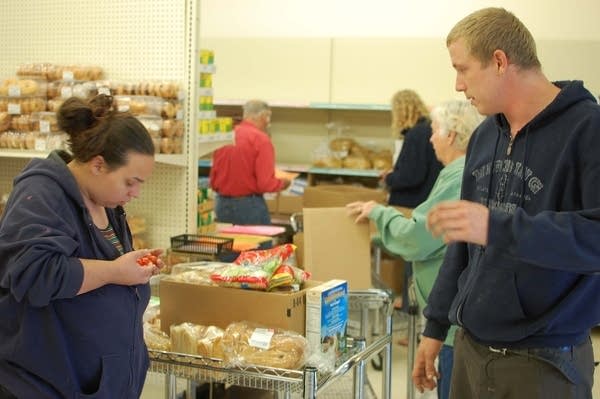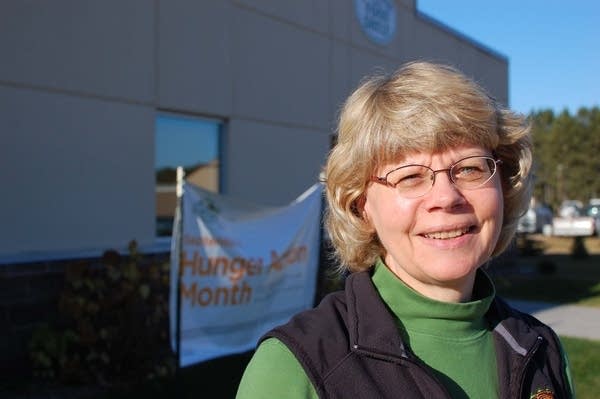Demand at rural food shelves keeps rising

Economists say the recession is technically over, but there are still plenty of signs of struggle in rural Minnesota.
Anyone with any doubt need only look at Itasca County, where more families are seeking food from shelves and social service agencies are seeing a spike in the number of people looking for help.
For many, surviving is made tough by a shortage of living-wage jobs. That's what's made the Grand Rapids food shelf a busy place. Aisles bustle with a mix of seniors and young couples picking up their monthly food packages.
Among them are Larry Goodwin and his wife, Cassie, both in their 20s.
Create a More Connected Minnesota
MPR News is your trusted resource for the news you need. With your support, MPR News brings accessible, courageous journalism and authentic conversation to everyone - free of paywalls and barriers. Your gift makes a difference.
"Babe, anything else?" Larry Goodwin asks his wife. "What did you get? I got a cake mix for you. Get pancakes."
Goodwin is a carpenter, but he said construction jobs are scarce. He said things started to go downhill for them when his seasonal job at a local golf course came to an end.
Cassie Goodwin is a certified nurse's assistant, but hasn't found a job in her field. Instead, she works at McDonald's.

"Right now we're just pretty much trying to live day to day," Larry Goodwin said. "And that's the way it's going to have to be right now. Right now I'm trying to find work again. ... It's absolutely ridiculous trying to look for a job around here."
Without monthly visits to the food shelf, the Goodwins say they'd go hungry.
"It makes me feel like some people deserve it more, but right now it's kind of hard for any of us to live in this environment," Cassie Goodwin said. "The economy is really horrible. Basically all our money goes out the door. We have nothing extra to spend on us, or household needs or anything."
Last year, food shelves in north central Minnesota saw a 14 percent increase in people coming for help. So far this year the demand is up another 10 percent, and the number could go higher.
Sue Estee, director of Second Harvest North Central Food Bank, said some new customers may be people who've come to the end of their unemployment benefits.

The nonprofit agency supplies food shelves in a seven-county region that runs from the Canadian border to south of Lake Mille Lacs.
Estee said unemployment in Itasca County is at about 9 percent. The region has lost good-paying jobs. Manufacturing is down. The timber industry is in decline.
Estee said she sees more families doubling up with housing. Many have trouble meeting their basic needs.
"We know that about 10 percent of the people we serve really are going without food, at least for part of the month, and those are the ones that reported they were hungry," she said. "A lot of people won't admit it, especially if it concerns their children."
Other agencies in Grand Rapids see similar increases in need. Jim Woehrle, director of community engagement for Kootasca Community Action, which serves Itasca and Koochiching counties, said 42 families asked for crisis assistance last month to help with their rent or mortgage.
That number may seem small, but it's a 60 percent increase so far this year. Applications for energy assistance are up nearly 20 percent from this time last year.
Woehrle said last year, agencies like his got funding boosts from the federal stimulus program. That money will run out soon, and he worries what will happen then.
"We'll be down about $100,000 for our crisis programs... and we're fearful that this is a continuing trend," he said. "Flat funding, reduced funding, and after awhile you just can't do that anymore."
State jobs analysts say it's not all bad news. The unemployment rate in Itasca County has actually improved slightly. Data shows that even in 2009, during the worst part of the unemployment dip, the county's annual payroll was down only 4.5 percent from its peak in 2005.
But people who lost manufacturing jobs see that as little consolation. There are roughly 500 fewer manufacturing jobs in the county than there were four years ago.
That includes people like John Week of Grand Rapids, who lost his job as a line supervisor last year. Week and his wife have four children, including a baby born just a few weeks ago.
Week used up his unemployment benefits. His family receives public assistance with food, health care and rent. He now works part time at McDonald's, where he earns minimum wage.
"I'm not extremely happy about working at McDonald's, but you know what? It's a job and it does bring in some form of money," Week said. "It's better than just sitting around and kicking rocks all day. We need more jobs around here so people can get back on their feet."
Minnesota jobless figures released Thursday show some gains in manufacturing jobs. But overall, employers trimmed nearly 10,000 jobs in September. Observers say it's another sign the economic recovery will be a painfully slow process.

